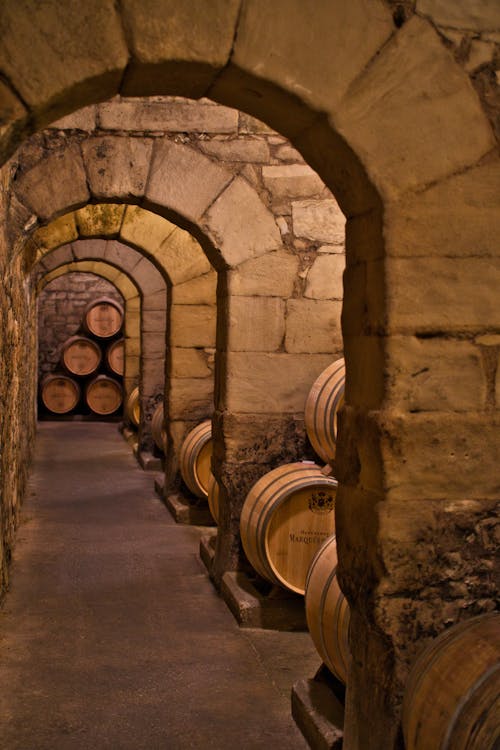Wine cellars have evolved significantly over millennia, from simple natural storage spaces to sophisticated architectural feats. This progression reflects technological advancements and the changing cultural and aesthetic values surrounding wine.
Historical Context: The Origins of Wine Storage

The earliest wine storage methods date back thousands of years, with ancient cultures leveraging natural caves and subterranean spaces to preserve wine. These early “cellars” offered consistent cool temperatures and high humidity, ideal for slowing the aging process and preventing spoilage.
- Ancient Mesopotamia and Egypt: Archaeological evidence from Mesopotamia (circa 6,000 BCE) suggests wine jars were stored in cool, dark environments like underground pits or cellars. Egyptians used amphorae sealed with clay or resin to store wine in subterranean granaries.
- Greek and Roman Influence: The Greeks advanced wine storage by building underground cellars with stone walls to insulate against heat. Romans took it further, constructing caldaria (hot rooms) and frigidaria (cold rooms) in villas, indicating an understanding of temperature control for optimal storage.
Significance: These early methods underscore the importance of preserving wine for religious ceremonies, trade, and social gatherings.
Design Innovations: Advancing Storage Solutions
With time, wine storage methods advanced, driven by architectural ingenuity and material innovation.
- Medieval Monasteries: During the Middle Ages, European monasteries became winemaking centers, using vaulted stone cellars beneath abbeys. These spaces provided natural insulation and protected wine from the elements, fostering the development of aging techniques.
- 17th-19th Centuries: Innovations like cork stoppers and glass bottles revolutionized wine storage, leading to purpose-built cellars in private homes. Georgian and Victorian estates featured wine cellars with brick-lined walls to maintain consistent temperatures.
Technological Influence: By the 19th century, thermometers and hygrometers became common in cellars, allowing owners to monitor storage conditions precisely.
Modern Developments: The Luxury of Contemporary Wine Cellars
Today, wine cellars are no longer mere storage spaces but architectural masterpieces that blend form with function.
- Climate-Control Systems: Modern cellars feature advanced technologies for regulating temperature (50-55°F), humidity (60-70%), and light exposure. Cooling units, humidifiers, and UV-resistant glass have become standard components.
- Aesthetic Integration: Contemporary designs prioritize visual appeal, incorporating custom shelving, LED lighting, and sleek finishes. Wine cellars are often designed as showcases, doubling as tasting rooms or entertainment spaces.
- Integration with Homes: Architects now incorporate wine storage into home layouts, from under-staircase cellars to full-fledged wine rooms that complement modern interiors.
Trend Alert: The rise of compact wine fridges and urban wine walls caters to city dwellers, making wine storage accessible without a traditional cellar.
Preservation Techniques: Balancing Science and Design
The science of wine preservation has shaped cellar architecture, ensuring wines maintain their quality over time.
- Temperature Control: Consistent temperatures prevent the expansion and contraction of wine, which can damage corks and spoil the contents.
- Humidity Management: Proper humidity levels keep corks moist, ensuring an airtight seal. Excess humidity, however, can encourage mold growth.
- Light Protection: Modern cellars often use UV-filtering glass or situate wine away from direct sunlight to prevent light damage.
Key Insight: Architectural design is pivotal in creating an environment that safeguards wine while enhancing its aging potential.
Cultural Significance: From Utility to Luxury
The role of wine cellars has transformed dramatically, reflecting broader societal shifts.
- Symbol of Status: In the Renaissance and beyond, wine cellars became symbols of wealth and sophistication, with elaborate designs showcasing fine vintages.
- Cultural Experiences: Today, wine cellars are experiential spaces where enthusiasts gather for tastings, fostering community and appreciation for winemaking.
- Architectural Showpieces: High-profile wineries commission renowned architects to design iconic cellars, blending art and utility. For example, Santiago Calatrava’s Ysios Winery in Spain is as much about visual impact as it is about preserving wine.
Conclusion
The architectural evolution of wine cellars encapsulates the interplay of tradition, innovation, and cultural value. From the humble natural caves of ancient civilizations to the technologically advanced and aesthetically pleasing cellars of today, each era has contributed to refining how wine is stored and celebrated. As modern designs continue to push boundaries, wine cellars remain a testament to humanity’s enduring reverence for this age-old beverage.

